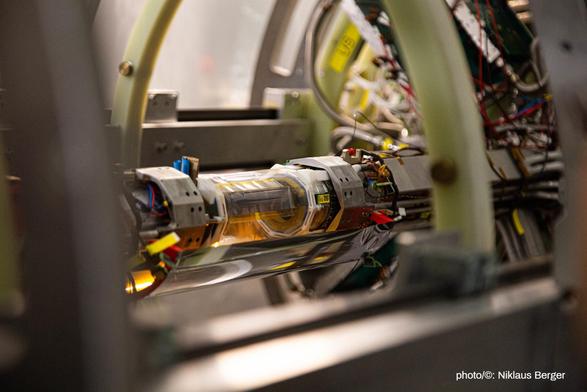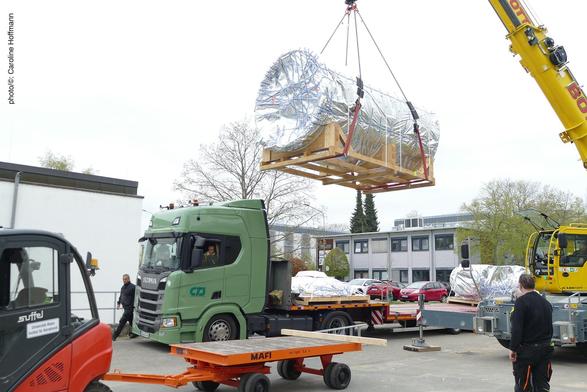#CMSPAS: Search for pair production of heavy resonances in photon plus large-radius jets final states in pp collisions at 13 TeV (CMS-PAS-B2G-24-006)
https://cds.cern.ch/record/2930565 #NewPhysics 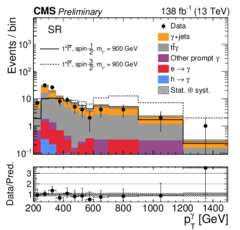
Search for pair production of heavy resonances in photon plus large-radius jets final states in pp collisions at 13 TeV
We present a search for the pair production of heavy spin-3/2 or spin-1/2 resonances ($\mathrm{t}^{*}$) in proton-proton collisions at $\sqrt{s}=13~\mathrm{TeV}$. We use data collected by the CMS detector at the CERN LHC from 2016 to 2018, corresponding to an integrated luminosity of $138~\mathrm{fb}^{-1}$. The analysis targets signal scenarios where one $\mathrm{t}^{*}$ decays into a top quark (t) and a gluon (g), and the other into a t and a photon ($\gamma$), via the process $\mathrm{pp}\rightarrow\mathrm{t}^{*}\bar{\mathrm{t}}^{*}\rightarrow\mathrm{tg\bar{t}}\gamma$. All-hadronic final states from the t pair decay chain are selected using jet substructure techniques. The mass of the $\mathrm{t}^{*}$ candidate is reconstructed using the photon and a top-candidate jet, which is then used to probe the signal.
No significant deviation from the background-only hypothesis is observed. Observed (expected) upper limits on the signal cross section at $95\%$ confidence level are set, excluding masses of spin-$\frac{1}{2}$ $\mathrm{t}^{*}$ particles below $940~(1000)~\mathrm{GeV}$ and spin-$\frac{3}{2}$ $\mathrm{t}^{*}$ particles below $1330~(1410)~\mathrm{GeV}$.
This analysis marks the first search for heavy resonances in the $\mathrm{tg\bar{t}}\gamma$ final state. Exploiting the high-energy photon, which reduces background despite the small $\mathrm{t}^{*}\rightarrow\mathrm{t}\gamma$ branching ratio, this search achieves sensitivity comparable to $\mathrm{pp}\rightarrow\mathrm{t}^{*}\bar{\mathrm{t}}^{*}\rightarrow\mathrm{tg\bar{t}g}$ searches.
#CMSPAS: Search for pair production of heavy resonances in photon plus large-radius jets final states in pp collisions at 13 TeV (CMS-PAS-B2G-24-006)
https://cds.cern.ch/record/2930565 #NewPhysics 
Search for pair production of heavy resonances in photon plus large-radius jets final states in pp collisions at 13 TeV
We present a search for the pair production of heavy spin-3/2 or spin-1/2 resonances ($\mathrm{t}^{*}$) in proton-proton collisions at $\sqrt{s}=13~\mathrm{TeV}$. We use data collected by the CMS detector at the CERN LHC from 2016 to 2018, corresponding to an integrated luminosity of $138~\mathrm{fb}^{-1}$. The analysis targets signal scenarios where one $\mathrm{t}^{*}$ decays into a top quark (t) and a gluon (g), and the other into a t and a photon ($\gamma$), via the process $\mathrm{pp}\rightarrow\mathrm{t}^{*}\bar{\mathrm{t}}^{*}\rightarrow\mathrm{tg\bar{t}}\gamma$. All-hadronic final states from the t pair decay chain are selected using jet substructure techniques. The mass of the $\mathrm{t}^{*}$ candidate is reconstructed using the photon and a top-candidate jet, which is then used to probe the signal.
No significant deviation from the background-only hypothesis is observed. Observed (expected) upper limits on the signal cross section at $95\%$ confidence level are set, excluding masses of spin-$\frac{1}{2}$ $\mathrm{t}^{*}$ particles below $940~(1000)~\mathrm{GeV}$ and spin-$\frac{3}{2}$ $\mathrm{t}^{*}$ particles below $1330~(1410)~\mathrm{GeV}$.
This analysis marks the first search for heavy resonances in the $\mathrm{tg\bar{t}}\gamma$ final state. Exploiting the high-energy photon, which reduces background despite the small $\mathrm{t}^{*}\rightarrow\mathrm{t}\gamma$ branching ratio, this search achieves sensitivity comparable to $\mathrm{pp}\rightarrow\mathrm{t}^{*}\bar{\mathrm{t}}^{*}\rightarrow\mathrm{tg\bar{t}g}$ searches.
Johannes Gutenberg University Mainz receives further funding for participation in the Mu3e experiment | Press and Public Relations
#CMSPAS: Search for low-mass hidden valley dark showers with displaced dimuons in proton-proton collisions at √s = 13 TeV (CMS-PAS-EXO-24-008)
https://cds.cern.ch/record/2930038 #NewPhysics 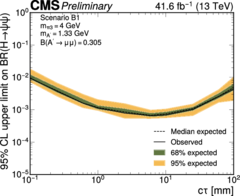
Search for low-mass hidden valley dark showers with displaced dimuons in proton-proton collisions at $\sqrt{s}=13~\mathrm{TeV}$
A search for signatures of a dark analog to quantum chromodynamics is performed. The analysis targets long-lived dark mesons that decay into standard model particles with a high branching fraction to muons. A unique dataset with $10^{10}$ B meson events is used. It was collected by the CMS experiment at the CERN LHC in 2018 using displaced muon triggers, which have a high trigger efficiency for the signal models. Resonant dimuon signatures are searched for, with both pointing and non-pointing topologies. No significant excess is observed beyond the standard model expectation. Upper limits on the branching ratio of Higgs boson decays to dark partons are determined to be less than $10^{-3}$, at $95\%$ confidence level, surpassing and extending existing limits for the mean proper lifetime of less than approximately $0.1~\mathrm{m}$ for a mass as low as $2~\mathrm{GeV}$. First limits are set for extended dark shower models, probing the low-mass region down to $0.33~\textrm{GeV}$.
Vacuum chamber of several tons delivered for the MESA particle accelerator | Press and Public Relations
#CMSPAS: Search for a heavy resonance produced in association with and decaying to a tt pair in the single lepton final state in proton-proton collisions at sqrt s = 13 TeV with the CMS detector (CMS-PAS-B2G-24-009)
https://cds.cern.ch/record/2929952 #NewPhysics 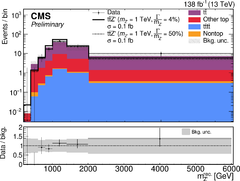
Search for a heavy resonance produced in association with and decaying to a tt pair in the single lepton final state in proton-proton collisions at sqrt s= 13 TeV with the CMS detector
A search for a top-philic $Z'$ boson in the final state with one electron or muon and jets is presented. The $Z'$ boson is produced in association with and decays to a top quark-antiquark pair, coupling exclusively to top quarks. The analysis aims to identify a heavy $Z'$ boson that results in Lorentz-boosted top quarks, whose hadronic decay products are merged into large-radius jets. We employ a machine learning algorithm (ParticleNet) to identify such jets. The distribution of invariant mass for the two most energetic top quark candidates is used to search for a $Z'$ boson in the mass range of 0.5 to 3 TeV with decay widths of \( 4\% \), \( 10\% \), \( 20\% \), and \( 50\% \) relative to its mass. They are found to be in agreement with the standard model background prediction. Upper limits at \( 95\% \) confidence level are set on the production cross section of the $Z'$ boson as a function of its mass, for each of the considered decay widths.
These results represent the most stringent constraints to date on the existence of the $Z'$ boson in the scenario where the $Z'$ boson exclusively couples to top quarks. The data were recorded by the CMS experiment at the CERN LHC in proton-proton collisions at $\sqrt{s} = 13$ TeV and correspond to an integrated luminosity of 138 fb$^{-1}$.
#CMSPAS: Search for a new scalar resonance decaying to a Higgs boson and a new scalar with two bottom quarks and two photons in the final state in proton-proton collisions at √s = 13 TeV (CMS-PAS-B2G-24-001)
https://cds.cern.ch/record/2929445 #Moriond #NewPhysics 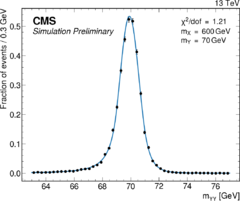
Search for a new scalar resonance decaying to a Higgs boson and a new scalar with two bottom quarks and two photons in the final state in proton-proton collisions at $\sqrt{s}=13\,\mathrm{TeV}$
A search for a new scalar resonance, X, decaying to a standard model Higgs boson and a new scalar particle, Y, is presented. The Higgs boson further decays to a pair of b quarks, while the Y particle decays to a pair of photons. The search is performed in the mass range $240-1000\,\mathrm{GeV}$ for the resonance X, and in the mass range $70-800\,\mathrm{GeV}$ for the particle Y, using proton-proton collision data collected by the CMS experiment at $\sqrt{s}=13\,\mathrm{TeV}$, corresponding to an integrated luminosity of $132\,\mathrm{fb}^{-1}$. Observed (expected) upper limits on the product of the production cross section and the relevant branching fraction at the $95\%$ confidence level are extracted for the $\text{X}\to\text{Y}\text{H}$ process, and are found to be within the range of $0.05-2.69\,(0.08-1.94)\,\mathrm{fb}$ depending on $m_\text{X}$. The most significant deviation from the background-only hypothesis is observed for X and Y masses of $300$ and $77\,\mathrm{GeV}$, respectively, with a local (global) significance of $3.33\,(0.65)$ standard deviations.
#CMSPAS: Search for new particles decaying into top quark-antiquark pairs in events with one lepton and jets in proton-proton collisions at 13 TeV (CMS-PAS-B2G-22-006)
https://cds.cern.ch/record/2929286 #Moriond #NewPhysics 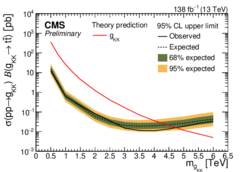
Search for new particles decaying into top quark-antiquark pairs in events with one lepton and jets in proton-proton collisions at 13 TeV
A search for new particles decaying to top quark-antiquark pairs is performed using proton-proton collisions at a centre-of-mass energy of $13~\mathrm{TeV}$. The data recorded with the CMS detector between 2016 and 2018 are used, corresponding to an integrated luminosity of $138~\mathrm{fb}^{-1}$. Events containing exactly one muon or one electron, at least two jets, and missing transverse momentum in the final state are considered. Different models of new physics are probed. No significant deviation from the prediction is observed and upper limits are set on the production cross section for heavy resonances. A Z' boson with $1\%$, $10\%$, and $30\%$ relative width is excluded for masses in the range 0.4$-$4.3, 0.4$-$5.3, and 0.4$-6.7~\mathrm{TeV}$, respectively. A Kaluza-Klein gluon in the Randall-Sundrum model and a dark matter mediator are excluded for masses between 0.5$-4.7~\mathrm{TeV}$ and 1.0$-3.2~\mathrm{TeV}$, respectively. Moreover, upper limits are set on the coupling strength modifier for scalar and pseudoscalar Higgs bosons in the two-Higgs-doublet models for $2.5\%$, $10\%$, and $25\%$ relative widths in the mass range 0.5$-1~\mathrm{TeV}$.
#CMSPAS: Search for tt resonances in the fully hadronic final state (CMS-PAS-B2G-24-003)
https://cds.cern.ch/record/2929080 #Moriond #NewPhysics 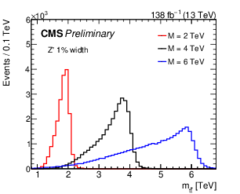
Search for tt resonances in the fully hadronic final state
A search for a heavy resonance decaying into a top quark-antiquark pair is presented, using $138~\mathrm{fb}^{-1}$ of proton-proton collision data collected at $\sqrt{s}=13~\mathrm{TeV}$ with the Compact Muon Solenoid (CMS) detector. This analysis employs machine-learning-based techniques for top quark identification in the fully hadronic decay channel and achieves improved sensitivity compared to previous searches. The search is optimized for highly Lorentz-boosted top quark decays, where the hadronic decay products are reconstructed as a single merged jet. Upper limits are set on the production cross section of a leptophobic topcolor $Z'$ resonance with widths of $1\%$, $10\%$, and $30\%$ of the resonance mass. These widths are chosen to cover a range of theoretically motivated models, enabling reinterpretation of the results. The corresponding lower mass limits for these benchmark scenarios are $4.49$, $5.52$, and $6.85~\mathrm{TeV}$, respectively. Additionally, two specific models are considered: a Kaluza-Klein excitation of the gluon in the Randall-Sundrum model, excluded up to $5.0~\mathrm{TeV}$, and a dark matter model with a massive mediator coupling to top quarks, excluded up to $3.9~\mathrm{TeV}$. These results represent the most stringent limits in this channel to date, particularly in the high-mass regime starting from $3~\mathrm{TeV}$.
#CMSPAS: Search for heavy resonances decaying into four leptons with high Lorentz boosts in proton-proton collisions at √s = 13 TeV (CMS-PAS-EXO-24-006)
https://cds.cern.ch/record/2928842 #Moriond #NewPhysics 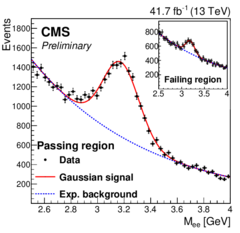
Search for heavy resonances decaying into four leptons with high Lorentz boosts in proton-proton collisions at $\sqrt{s} = 13~\mathrm{TeV}$
A search for a high-mass resonance decaying into four-lepton final states via two intermediate bosons is presented. The search uses proton-proton collision data at a center-of-mass energy of $13~\mathrm{TeV}$ collected by the CMS detector at LHC, corresponding to an integrated luminosity of $138~\mathrm{fb}^{-1}$. Signal hypotheses with a light intermediate boson may result in highly collimated decay products. Boosted electron pairs reconstructed into a single merged object are distinguished using a novel electron identification technique. A collimated muon pair may fail to reconstruct one of the tracks. In this case, the missing muon momentum is obtained from the missing transverse energy. No significant excess is observed. Model-independent upper limits on the product of cross section and branching ratio to four-leptons are set with $\mathrm{X}\rightarrow\mathrm{YY}\rightarrow\!4\ell$ and $\mathrm{X}\rightarrow\mathrm{Z}\mathrm{Y}\rightarrow\!4\ell$ channels for $M_{\mathrm{X}}$ from $250~\mathrm{GeV}$ to $2~\mathrm{TeV}$ and $M_{\mathrm{Y}}$ greater than $0.4~\mathrm{GeV}$ at $95\%$ confidence level.

